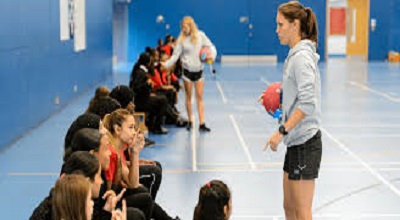Physical Education Teacher Training
Physical Education Teacher Training: Physical Education (PE) plays a crucial role in students’ overall development, promoting physical fitness, teamwork, and discipline. However, to deliver high-quality PE lessons, teachers must undergo specialized training. This blog explores the latest trends, components, and examples of Physical Education teacher training, providing insights for aspiring and current educators.
Why Physical Education Teacher Training is Important?
Physical Education is more than just sports and games; it fosters lifelong healthy habits. Proper training ensures that PE teachers can:
- Design engaging lesson plans that cater to different age groups.
- Promote inclusivity by adapting activities for students with disabilities.
- Integrate technology like fitness trackers and virtual coaching tools.
- Ensure safety by teaching correct techniques and preventing injuries.
Without proper training, PE teachers may struggle to keep students motivated or fail to address diverse learning needs.
Key Components of Physical Education Teacher Training
A. Theoretical Knowledge
PE teachers must understand:
- Human anatomy and physiology
- Sports science and kinesiology
- Nutrition and wellness principles
B. Practical Skills Development
Hands-on training in:
- Coaching various sports (basketball, soccer, gymnastics)
- First aid and injury prevention
- Fitness testing and exercise routines
C. Classroom and Field Management
- Strategies to maintain discipline
- Organizing group activities efficiently
- Handling conflicts among students
D. Assessment and Evaluation Techniques
- Tracking student progress
- Using rubrics for skill evaluation
- Providing constructive feedback
Latest Trends in Physical Education Teacher Training
A. Technology Integration in PE Training
- Wearable fitness devices (Fitbit, Garmin)
- Virtual reality (VR) for simulated coaching
- Mobile apps for lesson planning (Coach’s Eye, Sworkit)
B. Inclusive Physical Education
- Adaptive PE for students with disabilities
- Gender-neutral sports programs
- Culturally responsive teaching methods
C. Mental Health and Well-being Focus
- Incorporating mindfulness and yoga
- Addressing student anxiety through physical activity
- Promoting teamwork and emotional resilience
Step-by-Step Guide to Becoming a Physical Education Teacher
A. Educational Requirements
- Bachelor’s degree in Physical Education or related field
- Courses in sports science, health education, and pedagogy
B. Certification and Licensing
- State-specific teaching certification (e.g., Praxis exam in the U.S.)
- CPR and First Aid certification
C. Gaining Practical Experience
- Student teaching internships
- Coaching school or community sports teams
Examples of Effective Physical Education Teacher Training Programs
A. University-Based Programs
- University of Florida (UF) – Offers a specialized PE teacher training program with hands-on coaching.
- Springfield College – Known for its sports science and physical education degrees.
B. Online Certification Courses
- NASPE (National Association for Sport and Physical Education) – Provides online workshops for PE teachers.
- Coursera & Udemy – Host courses on sports psychology and fitness training.
C. Workshops and Seminars
- SHAPE America Conferences – Annual events for PE teachers to learn new techniques.
- Local School District Training – Many districts offer professional development workshops.
Challenges in Physical Education Teachers Training and Solutions
| Challenge | Solution |
|---|---|
| Limited funding for PE programs | Advocate for grants and community partnerships |
| Lack of qualified trainers | Encourage mentorship programs |
| Student disengagement | Use gamification and interactive tech |
FAQs on Physical Education Teachers Training
Q: How long does it take to become a PE teacher?
A: Typically 4 years for a bachelor’s degree + additional certification time.
Q: Can I teach PE without a degree?
A: Most schools require at least a bachelor’s degree and state certification.
Q: What skills do PE teachers need?
A: Leadership, communication, sports expertise, and classroom management.
Conclusion
Physical Education teacher training is evolving with new technologies and inclusive approaches. Whether through university programs, online courses, or workshops, aspiring PE teachers have multiple pathways to gain expertise.
